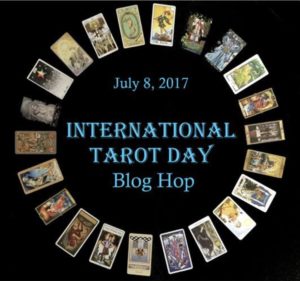I’d like to introduce you all to Bakara Wintner, the tarot expert I consulted with for The Fortune Teller.
Bakara and I first connected several years ago through my agent, Brianne Johnson, at Writers House. During that time Bakara gave me some fantastic feedback during revisions of my first novel, The Memory Painter. When I began writing The Fortune Teller, Bakara was now living in North Carolina, running her amazing new store Everyday Magic, and doing tarot readings full-time. (And here I was writing a tarot story! What are the chances?) So when Brianne suggested Bakara read the manuscript and get her feedback, I jumped at the idea. Bakara read one of the first drafts of The Fortune Teller early on and had some wonderful insights and suggestions.
Now Bakara has a book coming out, WTF is Tarot?:… & How do I do it?, on October 10th, and in celebration of her upcoming launch I wanted to introduce you all to Bakara and have her visit with us.
Hello Bakara & Welcome!
Gwen, thank you so much for asking me! I’m so excited about your newest book. I’m a proud longtime fan of your work.
Thank you! Congratulations on your upcoming book. I thought it’d be interesting for my readers to hear about your journey with tarot and get a peek into the life of an expert. What was your first experience with tarot cards and how did it lead to you becoming a tarot reader?
I first met the cards by chance. I was working in the publishing industry in New York City and going to therapy near my office. One morning before work I was in a session and my therapist told me she bought a deck for someone as a gift and asked if I would like to see it. As soon as she put the deck in my hands, I started to cry. Long story short, six months later I had quit my job to read tarot full time. It was a feeling of familiarity and recognition like I’d never experienced before.
If you were to tell someone, who is completely new to tarot, one thing about tarot cards, what would that be?
The most important thing I want newcomers to the tarot to know is that, while the prospect of learning the cards can be daunting, we already know these images and archetypes. Getting to know the tarot is not memorizing the meanings of seventy eight cards, it is identifying these energies and how they have already manifested in our lives. While it is an esoteric object, the tarot is a mirror of the human experience, and even someone approaching it for the first time is capable of grounding and humanizing these cards.
What is your favorite deck and why?
Well, at the risk of sounding totally cheesy, I am designing a tarot deck with a friend of mine who is an illustrator that is set to publish in October. I have yet to find a modern tarot deck that strips away superfluous imagery and lays bare each cards essential meaning, so eventually I decided to just make one. So, I’d say that one is my favorite haha. But for someone looking for a deck right now, The Rider Waite is one of the oldest and most universal tarot decks. Because it has survived the test of time and is so widely used, there are ample resources availble on this deck and its images specifically.
In less than a week your book will be out in the world! Can you tell us bit about WTF is Tarot?: …& How Do I Do It?) ?
WTF is Tarot? (…and how do I do it?) is my young blood approach to some very old magic. I’ve always believed that you do not need to learn the tarot because you already know it, and that familiarizing yourself with the cards is a matter of getting to know yourself better and deeper. So my approach on the cards in this book is helping people indentify moments in their life when they have been in the presence of a card’s energy. The time when you took a huge risk and didn’t know why you were doing it but only knew must – that’s The Fool. When you came to a crushing moment of clarity and asked “Wait, am I really still doing this shit again?” you were in the presence of the Wheel of Fortune. When you let go of a relationship with someone you loved but knew you needed to leave, you were leaning into Death. When you had an overwhelming feeling that you were exactly where you need to be, doing exactly what you should be doing, you were embodying the energy of Judgement. When you’re messing with a guy who keeps jerking you around, you’re hanging out with the Son of Wands.
Are there any other tarot books or websites or resources you recommend for people interested in learning more about tarot?
My two favorite resources on the tarot are Rachel Pollack’s Seventy Eight Degrees of Wisdom and Alejandro Jodorowsky’s The Way of the Tarot. Jodorowsky’s book focuses specifically on the Marseille Tarot, which is one of the oldest decks and a lot of the interpretation is specific to the imagery of those cards. However, I have found it to be universally useful. He has a section for each Major Arcana card that illustrates what each card would say if they could speak that is especially genius.
My novel, The Fortune Teller, delves into tarot and its history with some detail, but it also celebrates all forms of divination as tools to tap into inner-wisdom. Do you also use other tools as well or is tarot your main focus?
While tarot is my main focus, I incorporate several healing modalities into my practice to offer my clients a holistic experience when tarot alone is not enough. Crystals, aromatherapy, inner child rescue, body work, and sound healing are a few tools I use to supplement a reading. The tarot digs up an incredible amount of information, more than the cognitigive mind can grasp in a single sitting. If a client is feeling overwhelmed, or something comes up in a reading that needs immediate attention, I’ve found it useful to be trained in additional ways to help them.
I love the name of your store, Everyday Magic. I think it taps into that sense so many of us have to try and bring more magic into our lives. What gave you the idea for the store and what has been the most surprising thing you’ve found connecting daily with people who are looking to have that extra bit of magic in their lives?
When I was teaching tarot in Brooklyn, I hammered in the idea of Everyday Magic to my students. I don’t believe that magic is a rarefied phenomena, nor does it serve us to look at is as such. When I was coming up with the name for the store, it was actually one of my students who told me to name it Everyday Magic. I had been visiting North Carolina for years and knew I wanted to move there, and one time I was at dinner down here with some friends and saw an empty storefront across from me and decided in that moment that’s what I would do when I moved down here. It was nothing I’d ever considered before, but I knew the moment the thought came into my head that it was right. I’d been encouaging my clients to gather energetically meaningful, intentonal objects in order to make their homes a sacred space. Creating a shop where I could put all those objects in one space and offer it to my new community was an exciting prospect. The most surprising, and amazing part of operating Everyday Magic is seeing the most unexpected people come in and create deep connections to the wares we sell. We’ve had more people than I can count come in and buy their first-ever crystal, and then we see them again and again. Seeing how children intitively connect with the tarot decks and crystals in the shop has also been profound.

Is there anything else you’d like to share before signing off?
To everyone who feels nervous, or afraid, or daunted by the prospect of magic, please don’t be. It belongs to all of us, and the tarot is just one way of accessing this energy and integrating it into your life. It will change everything, it will open your eyes and your heart which can sometimes be difficult, but receiving my tarot deck is the single best thing that’s ever happened to me.
Bakara, thank you so much! I hope to visit you in Durham some day. For anyone wanting to connect with Bakara, you can find her on Instagram at @bakaraw
Here the website to her gorgeous store Everyday Magic.
And here is the link to preorder WTF is Tarot?: … And How Do I Do It?




 Today in celebration of Canada Day I’m thrilled to welcome Emily E. Auger to my website. Emily is a Tarot scholar from Canada and the editor of the 2-volume book Tarot in Culture, the most ambitious compilation on the subject since Stuart Kaplan’s Encyclopedia of Tarot. Tarot in Culture is a collection of papers by Tarot experts delving into every aspect of the subject, not only about the history of Tarot but about Tarot in art. Volume One centers around history and Volume Two focuses on the literary and artistic aspects.
Today in celebration of Canada Day I’m thrilled to welcome Emily E. Auger to my website. Emily is a Tarot scholar from Canada and the editor of the 2-volume book Tarot in Culture, the most ambitious compilation on the subject since Stuart Kaplan’s Encyclopedia of Tarot. Tarot in Culture is a collection of papers by Tarot experts delving into every aspect of the subject, not only about the history of Tarot but about Tarot in art. Volume One centers around history and Volume Two focuses on the literary and artistic aspects.

